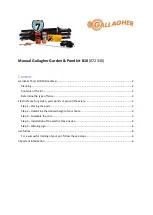
Chapter 1: Procedures
17
Adjustable parameters
If you feel you need to fine tune the SPX system performance, you can do so by using
one or more of the procedures below to adjust:
•
Rudder gain.
•
Counter rudder
•
AutoTrim.
If your SPX system ‘hunts’, i.e. continuously moves the steering backwards and
forwards by small amounts, you can also adjust rudder damping to prevent this.
Over time you may wish to repeat these adjustments using a range of sea conditions
and headings to achieve optimum all-round performance for your particular vessel
and preferences.
Adjust these settings when motoring your boat at cruising speed.
Setting response level
Before proceeding with any manual adjustment, set the response level to 5 as follows:
1. Enter Dealer calibration as described on
page 7
.
2. Use
disp
as necessary to access the RESPONSE screen.
3. Use the
-1
or
+1
key or the
up
and
down
arrow
keys to set a response of 5.
4. Hold down
standby
for 2 seconds to save the setting and leave Dealer
calibration.
Rudder gain
Boats can vary widely in their response to helm, and by adjusting the rudder gain you
can change the steering characteristics of the SPX system. Rudder gain is a measure
of how much helm the SPX system applies to correct course errors – higher settings
mean more rudder is applied.
Checking
Complete the following test to determine whether the rudder gain is set correctly:
1. Ensure you have set the SPX response to level 5, as described above.
2. Motor your boat at a typical cruising speed in clear water.
It is easier to recognize the steering response in calm sea conditions where wave
action does not mask steering performance.
3. Press
auto
to enter Auto mode, then alter course by 40°:
•
If the rudder gain is adjusted correctly, the 40° course change should result in
a crisp turn followed by an overshoot of no more than 5°.
•
If the rudder gain setting is too high, the 40° course change will result in a
distinct overshoot of more than 5° and there may be a distinct ‘S’ in the course,
as at
(A)
.
Correct this oversteer by reducing the rudder gain, as described below.
•
If the rudder gain is too low, the boat’s performance will be sluggish – it will take
a long time to make the 40° turn and there will be no overshoot
(B).
Correct this understeer by increasing the rudder gain, as described below.
81307_1.book Page 17 Wednesday, December 19, 2007 11:17 AM
















































